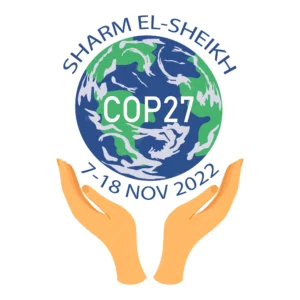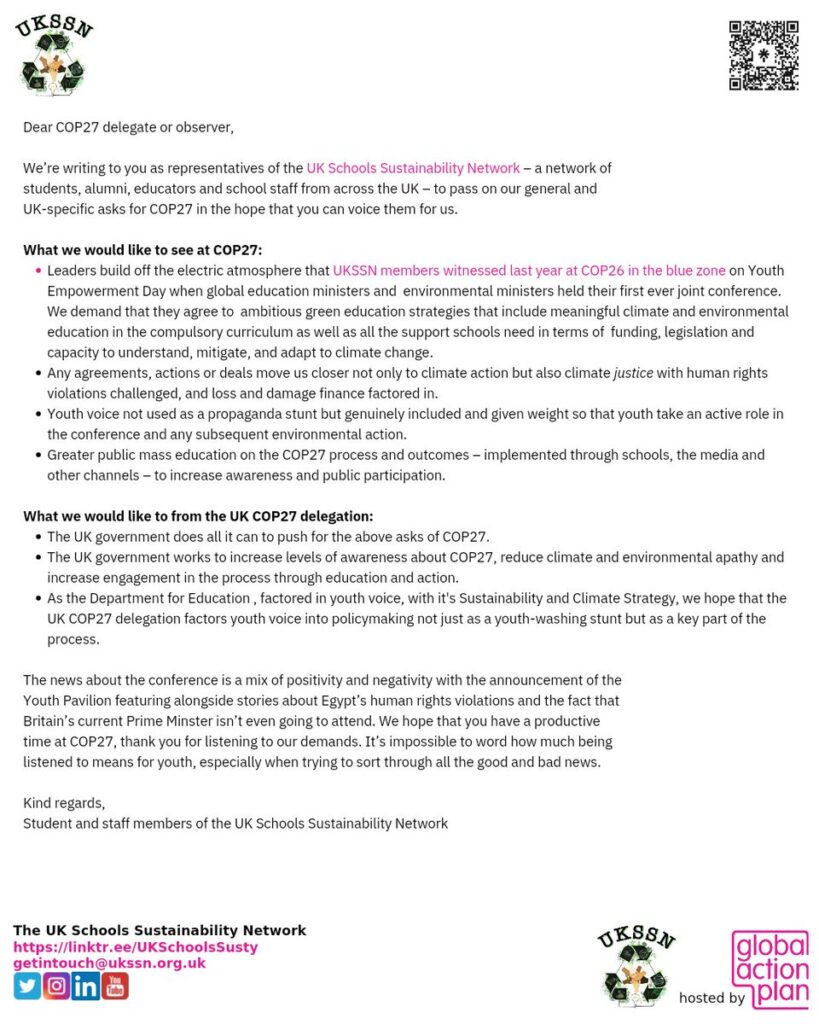19 Nov COP27 What did we learn and achieve

We learnt:
- Women were largely absent from climate negotiations
- Greta didn’t go but other activists to look out for are: Sophia Kianni, Vanessa Nikate, Ayisha Siddiqa, Mana Omar, Pervez Ali
- Russia’s invasion of Ukraine has caused a large amount of warming gases to be released into the atmosphere. The amount is the equivalent of adding nearly 16 million cars to the UK’s roads for two years. It has come from burning oil, burning of forests, bombing cities, sabotage of the pipelines leading to huge amounts of bubbling methane (indirectly linked to war)
- New president Lula of Brazil is committed to saving the Amazon rainforests from destruction
- The world leaders are good at producing documents saying what action is needed but not very good at the doing part.
- US climate envoy John Kerry has Covid and he was the key negotiator at Glasgow.
- 636 fossil fuel lobbyists registered to attend COP27, many affiliated with the world’s biggest oil and gas giants — more than any single national delegation in attendance except the United Arab Emirates (25% increase on last year).
- Coca Cola, one of the world’s largest polluters of plastic, was the sponsor of this conference.
We argued about:
- Phasing out the use of all fossil fuels, particularly coal: Last year’s summit agreed to the “phase down” of the use of coal – now some countries want to extend the “phase down” to oil and gas too (India is most upset because they have really pushed for the developed countries to send money to the less developed countries, and then they found out that they are being classified as one of the developed countries so they will have to pay out and don’t get money given to them)
- Keeping the target of only 1.5C of global warming alive: There are concerns that the commitment to this threshold might be watered down
- Loss and damage financing for vulnerable countries: Calls for a new fund to help countries deal with the immediate impacts of climate change. But who’s going to pay for it
- Relations over climate issues between the US and China: A lack of concrete areas of co-operation between the two countries is hampering the UN climate process
What we achieved at COP27:
Headlines:
A loss and damage fund for developing countries was agreed. Who will pay was not decided and will be left until COP28
Nothing was decided about phasing out oil and gas. The phase down of coal from COP26 still stands but no further detail provided about how it will be done.
The 1.5oC target has not been changed from COP27 which states we need to reduce gas emissions by 43% by 2030 even though scientists feel that is not enough to keep warming to 1.5oC.
Bridgetown agenda suggests reforms to the international financial system playing a part in finding $5.6 trillion needed for developing countries to meet their 2030 goals. To be further discussed.
Carbon trading rules looked at to stop double counting carbon credits, but is still only a suggestion.
Energy transition to cleaner fuel – statements about finding the money for South Africa and Indonesia.
Framework for tracking adaptation moved forward but no working document yet.
Special status for Africa and Latin America and Caribbean countries not granted.
What we agreed at COP26:
- phase-down (changed at the last minute from out) of “unabated coal power and inefficient fossil fuel subsidies” (Unabated coal is coal produced without the use of technology to capture the emitted carbon.)
- Brazil has pledged to stop deforestation in the Amazon rainforest by 2030 but Indonesia changed their mind and backtracked.
- Britain has legislated to ban the sale of new fossil fuel cars by 2030. Experts predict that new electric vehicles could cost the same as new petrol or diesel cars within the next five years.
- For countries like the UK, investing in renewables will mean continuing the move towards renewable sources such as wind and solar energy – and possibly more reliance on nuclear energy. Solar panels and heat pumps could become standard in our homes.
- Governments of 28 countries also committed to remove deforestation from the global trade of food and other agricultural products such as palm oil, soya and cocoa.
- More than 30 of the world’s biggest financial companies – including Aviva, Schroders and Axa – have also promised to end investment in activities linked to deforestation.
- And a £1.1bn fund will be established to protect the world’s second largest tropical rainforest – in the Congo Basin.
- Commitments include supermarkets pledging to cut their environmental impact across climate and nature-loss and fashion brands guaranteeing the traceability of their materials.
- 10 new countries signing up to the ‘30by30’ target to protect 30% of the world’s ocean by 2030
- US would lead by example, and announced it would spend $9bn (£6.6bn) to conserve and restore forests.
- There’s also a significant doubling of money to help poor countries adapt to the impacts of climate change – and the prospect of a trillion dollar a year fund from 2025
- $8.5 billion dollars has been pledged to help South Africa move to clean energy.
- The UK said it has found $130 trillion dollars of private finance to help finance net zero
- However, the $100 billion promised at Paris to help less developed countries has not materialised gaining only S$ 232.6 million in New Pledges at COP26.
- More than 100 countries agree to cut emissions of methane by 30% by 2030. ajor emitters like Russia, China and India are not part of the pledge.
- The UK today pledged £27.5m of new funding for the new Urban Climate Action Programme (UCAP) to support cities targeting net zero. The programme will support cities by helping them implement innovative climate action plans to become carbon neutral by 2050 and prepare low-carbon infrastructure projects to reduce emissions.
- Countries are asked to “revisit and strengthen” their 2030 emissions-cutting targets by the end of 2022, “taking into account different national circumstances”
- The Fashion Industry has announced the Race to Zero. This may be the beginning of the end of fast fashion
It will take a while to review these targets a year on. However there is one target that has gone horribly wrong.
Target:
And a £1.1bn fund will be established to protect the world’s second largest tropical rainforest – in the Congo Basin.
One year later:
Congo to Auction Rainforest Land to Oil Companies.
What we agreed at COP27:
A loss and damage fund for developing countries was agreed. Who will pay was not decided and will be left until COP28
Nothing was decided about phasing out oil and gas. The text promotes renewable energy and low-emission energy which can be interpreted as gas and fossils fuel with carbon capture. These added phrases are probably as a result of the very large fossil fuel lobbyists as behind closed doors. Oil producers argued that oil does not cause climate change but emissions do. The phase down of coal from COP26 still stands.
The 1.5oC target has not been changed from COP27 which states we need to reduce gas emissions by 43% by 2030 even though scientists feel that is not enough to keep warming to 1.5oC. It was left to COP27 to discuss how to scale up mitigation. Nothing has been decided and a target of 2026 ws decided for when decisions need to be made on this.
Bridgetown agenda suggests reforms to the international financial system with multilateral development banks and international institutions playing a part in finding $5.6 trillion needed for developing countries to meet their 2030 goals. Countries have agreed it needs looking at.
Carbon trading rules. Countries are banned for double counting carbon credits but there is a loophole. When a company offsets their carbon emissions by paying for someone else for example to pant trees then both people are not meant to count the savings against their own emissions. However their is a loophole as there is nothing in law to stop this happening and could lead to corporate greenwashing.
Energy transition. South Africa has published details about $84bn to transition to clean energy. Rich countries have announced a similar $20 bn deal with Indonesia. An similar agreement with Viennam is proper by the end of the year.
Adaptation
Work to define the Global Goal on Adaptation inched forward.
Countries agreed to develop a framework to guide delivery of the goal and track progress. This will take into account countries’ vulnerability and capacity to cope, consider a range of themes include water, food and agriculture and poverty, and science-based indicators, metrics and targets.
Climate Finance
Developed countries are 3 years late to deliver the $100 billion they promised by 2020 to help developing countries cut emissions and cope with climate impacts. Decisions as to where more money will come from has been delayed until 2023.
Special Status
African countries failed to have their circumstances recognised as special status, therefore unlocking international help. Latin America and the Caribbean countries argued if Africa gets special status then so should they.
Young people made an impact at this COP27.
They were included in some of the delegations and allowed to speak.
Article 89, 93, 94 and 95 in the document talk about encouraging youth to play a part in designing and implementing climate policy. They also used words like appreciated the Youth organising the COY15 conference and the input of young people.
Is it what we wanted?




No Comments